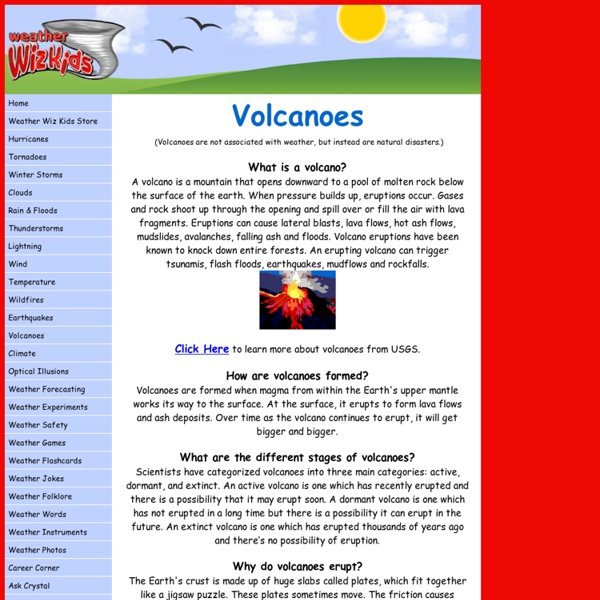Weather Wiz Kids weather information for kids

Fun Volcano Facts for Kids - Interesting Facts about Volcanoes
Volcanoes are openings in the Earth’s surface. When they are active they can let ash, gas and hot magma escape in sometimes violent and spectacular eruptions. The word volcano originally comes from the name of the Roman god of fire, Vulcan. Volcanoes are usually located where tectonic plates meet. This is especially true for the Pacific Ring of Fire, an area around the Pacific Ocean where over 75% of the volcanoes on Earth are found. While most volcanoes form near tectonic boundaries, they can also form in areas that contain abnormally hot rock inside the Earth.
What is a volcano?
Introduction to volcanoes The earth's mountains, plains, plateaus, soils, rocks, etc. as we see it today is believed to have gone through many phases, with about 80% of it being carved out by the action of volcanoes. A volcano is simply a rapture (opening or vent) on the earth's surface (crust) through which molten magma (extremely hot mixture of gases, lava, ash and other burning substances) escape on to the earth's surface. How do Volcanoes look like? In May 1980, the Mountain St. Volcanoes occur at weak zones or points in the earth’s crust (including constructive and destructive boundaries). For history lovers… In A.D. 79 (really long ago) two Roman cities, Pompeii and Herculaneum, were completely buried in ash and dust in a matter of hours after a volcanic eruption. The word, ‘volcano’ was made out of the name of a Roman god of a small island in the Mediterranean sea of Sicily called ‘Volcan’. Now we shall see in a bit more detail how volcanoes come about.
what do young people wear in volcanic areas?
it has good videos on it
Weather wiz kids note Alaina, jessica, and Amelia
Quiz Whiz: Volcanoes
Back Next Quiz Whiz: What's on the Menu? Previous Quiz Whiz: The Moon Games Quiz Whiz: Volcanoes See how much you know about explosive mountains known as volcanoes. More Games African Animals Maze Game Quick Play Arctic Animal Memory Action Arctic Fox Snowboarding Animals Beaver Badminton Dive Deeper Hurricanes 101 - Ep. 3 More Freaky Forces of Nature Auroras, Snow Rollers, and Other Freakiness! Earthquake Lightning Tornado Many cave-dwelling fish don’t have eyes. More Curious Facts Volcanoes 101 - Ep. 13 More Giant's Causeway - Ep. 12 More Tornadoes 101 - Ep. 2 Hurricane Dolphin Diving x Show Link
can volcanic gases kill you?
Because they are feeling adventurous.
kilauea reaches 1,160 degrees celsius 2,120
how hot is lava?
Related:
Related:



